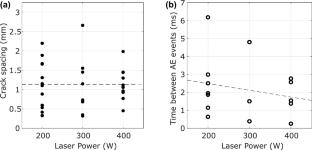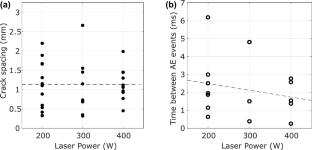Detection and Classification of Cracking Via Acoustic Emission During Laser-Melting Screening for Additive Manufacturing
Abstract
Metal additive manufacturing provides opportunities for fabricating complex, high-performance parts. However, the processing demands of laser powder bed fusion have limited the availability of materials that are amenable to 3D printing, motivating development of new alloys that have low defect susceptibility. High-throughput screening tools are necessary to evaluate these new alloys and decrease prohibitive development costs. Acoustic emission sensing utilizing a piezoelectric sensor is investigated as a method for in situ crack detection during single-track laser melting experiments which are set to replicate laser powder bed fusion processing conditions. Two materials found to exhibit either solidification cracking (CMSX-4) or solid-state cracking (TZM) are examined, ultimately showing the experimental setup can detect individual solid-state cracking events but not solidification cracking events. Calibration of the sensor with ball-bearing drop tests down to 0.04 \(\upmu \)J provides a useful assessment of the sensitivity of the technique. Furthermore, the acoustic emission data can be used to determine relative differences in crack size with varying scanning parameters (laser power, scan speed) and gain insight into the crack initiation characteristics of the material.



 求助内容:
求助内容: 应助结果提醒方式:
应助结果提醒方式:


